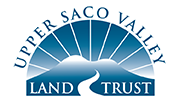A History of Jockey Cap - By Doug Burnell
Jockey Cap was one of those outsized wonders of my childhood summer days spent in Fryeburg at our nearby camp on Lovewell’s Pond. Wonderful enough was the profile of this giant bare ledge protruding out from the surrounding pitch pine/scrub oak plains, but add in the dark mysteriousness of Molly Ockett’s Cave at the base, the delightful airiness of the scramble up sparkling garnet and mica–infused slab, and the solid presence of the Admiral Peary rangefinder naming countless peaks in a 360º sweep from the top, and shear magic was achieved!
Overlooking their cultivated floodplain fields along the Saco River, the Pequawket tribe of the western Abenaki confederacy lived in a sizeable village on the flank of Pine Hill. The river served as their main highway to the coast, and Jockey Cap marked the route of a flat two-mile portage from the village through Lovewell’s Pond, which saved 30 miles of river travel around the Great Bend of the Saco. Spurning the planned town center where founder Joseph Frye built his house three miles to the north, the early Fryeburgers of European descent instead settled around the Pequawket’s old well-situated village, leaving Jockey Cap just on the edge of town. Meanwhile, Molly Ockett, the remarkable wife of Chief Paugus and likely the last member of the Pequawket Tribe to live locally, resided when she was in the area in a namesake boulder cave at the foot of Jockey Cap.
The landmark ledge occupied the west end of a narrow original town lot stretching eastward across the plain to an early highway which is now part of the Lovewell Pond Road. In 1879, ownership of the Jockey Cap lot was divided between the patriarchs of two prominent Fryeburg families, the Hastings and the Pikes, a shared private ownership which continued mostly by inheritance through several generations and eventually ended up solely in the Pike family.
In the fall of 1936, the three pieces of a 3-ton granite pedestal were somehow carried up to the high point of the ledge, the base for a rangefinder designed by discoverer of the North Pole Robert E. Peary when he lived in Fryeburg Village for two years after graduating from Bowdoin College. Over the next two years, a bronze casting of Peary’s surrounding mountains’ profiles was carefully designed, tried out first in plaster, and refined for its final placement on top of the pedestal and dedication as the Peary Memorial in August 1938. The attached photo of Admiral Peary’s family at the dedication was taken by my father when he was a youthful burgeoning photographer.
Over the two winters spanning the same period, 1936 to 1938, a ski slope and automobile-engine-powered rope tow – purportedly the first in Maine -- operated on the east flank of Jockey Cap, uphill from today’s new trailhead parking lot. Many snow train arrivals and locals came out for coaching and for ski ‘coasting’ and ‘sliding’ on runs here and onto Weston’s Farm land off the backside of Pine Hill and at Stark’s Hill. One of those fine ski days is depicted in the attached photograph.
The following summer of 1938, all the Jockey Cap lot east of Route 302 was sold off, and about the same time a wayside store/filling station was built just west of the shortest route up to Molly Ockett’s Cave over the land to the west. [A white wooden archway always marked the entrance to the trail out of the store parking lot, the latest version of which arch has nostalgically been moved to the new 2024 trailhead.] As the Jockey Cap Store ownership changed hands multiple times, a string of cabins was added to the east of the trailway. Shortly after the cabins and land east of the store were sold off to a holding LLC in 2015, the Jockey Cap Trail was moved to the west side of the old store, the cabins and any trees and lawn disappeared, and a big-box Dollar General store with spacious paved parking lot was constructed.
As other commercial development rapidly covered the land across the highway from the store, other surrounding properties became developed as well. A house sprang up on the nearest lot to the north of Jockey Cap around 1990, part of a large residential development on the long ridge trailing off that side. Later, a call tower rose above the ridgetop trees. Another house accessed by a long driveway off Rte. 302 was built in the mid-90s high up to the east of that ridge lot, and more recently a large solar farm and self-storage units were erected on the Rte. 302 land to the east of the Jockey Cap lot. Increasingly, the Jockey Cap property was becoming an oasis of natural beauty.
In 1995, one of the Pike heirs conveyed his acquired half-interest in the Jockey Cap property to the Town of Fryeburg, while the other half-interest remained under the ownership of Helen Pike Leadbeater. Helen was a renowned amateur archeologist whom I spent some of my idle boyhood summer time observing and ‘helping’ uncover fire rings, pottery shards, and flint scrapers and arrowheads from the long, vacant stretch of sandy beach next to our camp. Helen’s son Randy, later known as Arizona Zipper, and a long-time friend of our family, inherited his mother’s Jockey Cap half-interest in 1998; kept the property preserved, albeit essentially unmanaged in its split-ownership limbo; and graciously sold it to USVLT for conservation in 2021 as his health was failing.
-1.png)
 (1).png)

